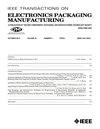Parameter Modeling for Wafer Probe Test
IEEE Transactions on Electronics Packaging Manufacturing
Pub Date : 2009-03-27
DOI:10.1109/TEPM.2009.2017514
引用次数: 11
Abstract
This paper presents the simulation of parameters for wafer probe test by finite-element modeling with consideration of probe over-travel (OT) distance, scrub, contact friction coefficient, probe tip shapes, and diameter. The goal is to minimize the stresses in the device under the bond pad and eliminate wafer failure in probe test. In the probe test modeling, a nonlinear finite-element contact model is developed for the probe tip and wafer bond pad. Modeling results have shown that the probe test OT, probe tip shape and tip diameters, contact friction between the probe tip and bond pad, as well as the probe scrub of the probe tip on bond pad are important parameters that impact the failure of interlayer dielectric (ILD) layer under bond pad. Comparison between probe test damage and wire bonding failure shows the degree of damage to both probe test and wire bonding on the same bond pad structures. In addition that, a design of experiment (DOE) probe test with different ILD and metal thickness is carried. The correlation between the modeling and the DOE test is studied. The results show that the modeling solution agrees with the DOE probe test data. Modeling results have further revealed that probe test can induce the local tensile (or bending) first principal stress in ILD layer, which may be a root cause of the ILD failure in probe test.晶圆探头测试参数建模
本文采用有限元模型对晶圆探头测试参数进行仿真,考虑了探头超行程距离、摩擦系数、接触摩擦系数、探头尖端形状和直径等因素。目标是最小化键合垫下器件的应力,并消除探针测试中的晶圆失效。在探针测试建模中,建立了探针尖端与晶圆键合垫的非线性有限元接触模型。模拟结果表明,探针测试OT、探针尖形状和探针尖直径、探针尖与键垫的接触摩擦以及探针尖在键垫上的摩擦是影响键垫层间介电层失效的重要参数。通过对探头试验损伤和焊线破坏的比较,可以看出在同一焊盘结构上,探头试验和焊线损伤的程度。此外,还进行了不同ILD和不同金属厚度的实验探针测试设计。研究了模型与DOE试验的相关性。结果表明,模型解与DOE探测试验数据吻合较好。模拟结果进一步表明,探针试验可以诱发ILD层局部的拉伸(或弯曲)第一主应力,这可能是探针试验中ILD失效的根本原因。
本文章由计算机程序翻译,如有差异,请以英文原文为准。
求助全文
约1分钟内获得全文
求助全文

 求助内容:
求助内容: 应助结果提醒方式:
应助结果提醒方式:


